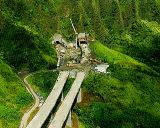


| -------- -------- & Specials -------- |

©1996-2001 |
|
-----
The H-3 Underground
This picture is of the Haiku portals under construction on the Windward side of Oahu in Kaneohe.
Please click on the pictures to view the images at full size.
The H-3 tunnels were built in a drill & blast method. Before any of the drilling or blasting was done, though, engineers dug an exploratory tunnel for the road tunnel to follow. Surveyors calculated the tunnels position using triangulation. A point on the top of the mountain is lined up with points on two sides of the mountain. This gives workers a starting point. In order to prep the mountain for the tunnels, workers first made a vertical cut down the side of the mountain. Then 10 foot long bolts were stuck straight into the mountain to keep the "small" (several hundred pounds) boulders from coming loose. A giant machine called a roadheader is used to drill through the mountain. Sometimes the roadheader would hit rock that was too hard to bore through. In fact rock on the Halawa side of the Ko'olaus is actually softer than rock on the Haiku side. When the roadheader gets "stuck", the blasting crews are brought in.
First, the workers drilled 10 foot deep holes into the rock, 2 feet apart. Plastic pipe is inserted into the holes and explosives are inserted into the pipes. The rock is blown apart and the rubble is cleared away. Finally, workers spray the bare rock with a mixture of concrete and steel fibers to hold it in place. The tunnel walls are made by putting down a layer of shortcrete, then a layer of welded wire "fabric", next the wire is fastened down with dowels, and finally another layer of shortcrete is added for strength. Even with all of the drilling and blasting, the work is not very hazardous. As long as everything is done correctly, no one should get hurt.
The giant tunnel entrances of The H-3 are called "portals". The giant slits on the tops of the tunnel entrances are not walkways, but rather ventilation shafts for the 4-10 foot high fans that allow air to move through the tunnels. These fans are built in a winged design that acts as silencers for these giant fans. They are capable of creating a breeze of up to 15 mph.
A lot of supplies were used in creating the H-3 tunnels. 500,000 cubic yards of rock were removed when the tunnels were drilled. For lighting, 5,000 high pressure sodium lights were used and there are over 30 miles of fiber optic cable embedded in the concrete walls.
18 million pounds of steel were used in reinforcing the 115,000 cubic yards of concrete for the tunnels. The walls of the tunnels are covered in 3.3 million ceramic tiles. These tiles were imported directly from Germany and are individually hand placed.
At its peak, there were 400 people working on the tunnels 24 hours a day. Now that the entire highway is finished, there are 38 workers who run the tunnel control center on the Halawa side of the mountain year round.
Where's the other half of the article? Right here.






